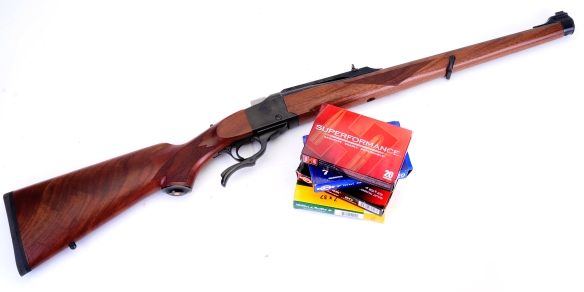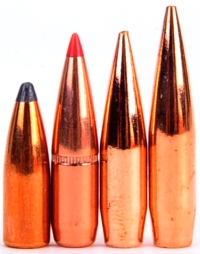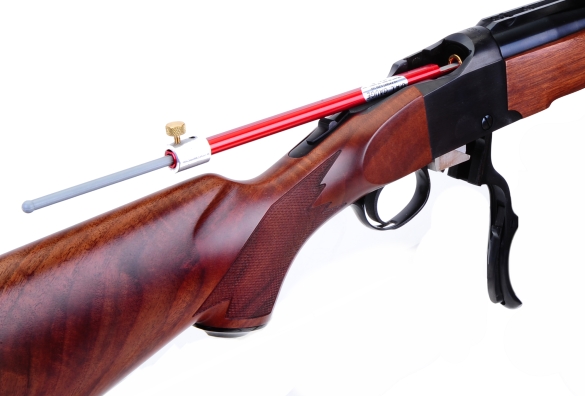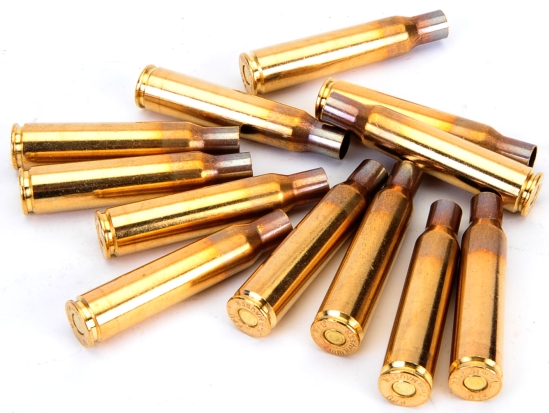
The Ruger No.1 produced good results with any mainstream factory ammunition we tried, delivering 1 to 1 1/2″ groups at 100 yards even with low cost Prvi ammunition. Chronograph data is indicated within Part 1. We decided to conduct a secondary handload project for several reasons. The first – Factory ammunition supply has been erratic in recent times so handloading assures supply. The second – There are many quality bullets for 7mm cartridges, but many are not loaded in factory ammunition. The third – SAAMI and CIP standard factory ammunition is intended to assure safe operation in a Model 1892 Spanish Mauser and kills the rounds potential in stronger firearms.
Rationale
 SAAMI’s 7x57mm Pmax is 51,000 PSI. The 7x57mm handloads listed on this page reflect a pressure ceiling between 57,000 and 60,000 PSI, or approximately the same levels of pressure and bolt thrust as the 7mm-08 Remington (60,191 PSI Pmax) and the 244 Remington (62,366 PSI Pmax). The 244 Remington is a 7x57mm derivative cartridge and all references are/were available as Ruger No.1 factory chambers. The data appearing on this page applies uniquely to the Ruger No.1.
SAAMI’s 7x57mm Pmax is 51,000 PSI. The 7x57mm handloads listed on this page reflect a pressure ceiling between 57,000 and 60,000 PSI, or approximately the same levels of pressure and bolt thrust as the 7mm-08 Remington (60,191 PSI Pmax) and the 244 Remington (62,366 PSI Pmax). The 244 Remington is a 7x57mm derivative cartridge and all references are/were available as Ruger No.1 factory chambers. The data appearing on this page applies uniquely to the Ruger No.1.

| Bullet | Weight Grains |
Length” | COL” |
| Sierra ProHunter | 120 | 0.980 | 2.985 |
| Hornady SST | 139 | 1.263 | 3.000 |
| Berger VLD Hunting | 140 | 1.270 | 3.065 |
| Berger VLD Hunting | 168 | 1.425 | 3.065 |
The bullets indicated above, and pictured left, left to right, represent our current preference in bullets for 7mm cartridges. They fly straight, expand well but retain weight on impact. They also don’t break the bank on cost. The selection represents a move away from solid copper and solid shank bullets that add length, reduce stability, and diminish case capacity without adding to cartridge performance. Solid copper bullets are a politically correct product, not a good product.
Berger VLD bullets are primarily designed for use in firearms where magazine length and chamber throats permit longer than SAAMI specification cartridge overall length. In cases where this extra length is not accommodated, Berger offers their Classic Hunter product in a limited number of calibers and weights. These bullets have a shorter nose and will seat within SAAMI overall length specifications. In my experience, once the VLD ogive advantage is lost, quality Hornady, Sierra or Speer bullets could be substituted at 30% less cost.
It’s like a dipstick, only for bullets…
The single shot design of the Ruger No.1 eliminates magazine length restriction as a consideration when developing handloads. However, when exceeding the SAAMI over all cartridge length specification, some checking is required. A Hornady Lock-N-Load over all length gauge was used to determine the maximum assembled cartridge length for each specific bullet type.
![]()

The “Maximum Length” entry represents the length of a cartridge when the bullet comes to rest on the rifling leade with the breech closed. “Determined COL” is the assembled ammunition length after adjustment for safety clearance or appropriate bullet seating depth.
| Bullet | Weight Grains |
Maximum Length” |
Determined COL” |
| Sierra ProHunter | 120 | 3.080 | 2.935 |
| Hornady SST | 139 | 3.192 | 3.000 |
| Berger VLD Hunting | 140 | 3.175 | 3.010 |
| Berger VLD Hunting | 168 | 3.183 | 3.170 |
|
SAAMI Spec COL = 3.065″ |
|||
The Sierra ProHunter is listed in the Sierra reloading manual as having a 2.985″ COL. At this length, seating was deemed marginal so length was reduced to 2.935 and seating depth was increased to one caliber for proper neck retention. This, of course, rendered Sierra manual loads for this bullet invalid as the change reduced the case’s net powder capacity.
The overall length of the Hornady SST was reduced to 3.000″, consistent with the Hornady manual and the placement of the bullet’s cannalure. Alternatively, ignoring the cannelure, COL could be extended to 3.110″ with an increase in charge required to restore pressure levels.
The 140 grain Berger VLD was reduced to assure bullet diameter seating depth for adequate neck retention. The 168 grain VLD change reflects reducing overall length to assure no contact between bullet and rifling when the breech is closed.

Norma, Nosler, Remington, and Winchester produce component brass for the 7x57mm, however, loaded boxer and non-corrosive primed ammunition from Prvi actually costs less. So you get the one time use of quality ammo and brass formed to your rifle’s chamber for future handloading.
|
|||||||||||||
|
Bullet |
Bullet Weight |
Net Water Capacity |
COL” |
|
Powder Type |
Powder Charge |
Muzzle Velocity |
Muzzle Energy |
100 Yards |
| Sierra ProHunter | 120 | 54.9 | 2.935 | Re17 | 52.5 | 3107 | 2573 | 1.1 | |
| Sierra ProHunter | 120 | 54.9 | 2.935 | H414 | 54.0 | 3154 | 2651 | 1.2 | |
| Hornady SST | 139 | 51.6 | 3.000 | H414 | 50.0 | 2933 | 2656 | 1.0 | |
| Hornady SST | 139 | 51.6 | 3.000 | IMR4895 | 45.0 | 2787 | 2398 | 0.7 | |
| Berger VLD Hunting | 140 | 52.2 | 3.010 | Re17 | 49.0 | 2845 | 2517 | 1.1 | |
| Berger VLD Hunting | 140 | 52.2 | 3.010 | H414 | 50.5 | 2965 | 2734 | 0.9 | |
| Berger VLD Hunting | 168 | 52.3 | 3.170 | Re19 | 50.5 | 2662 |
2644 | 1.1 | |
| Berger VLD Hunting | 168 | 52.3 | 3.170 | H414 | 48.5 | 2730 | 2781 | 1.0 | |
So what did this exercise get me?

Hmmm… about the same performance, or even a bit more than the 7mm-08 Remington, as it should. Handloads also deliver 100 – 150 fps greater velocity than factory loaded 7x57mm ammunition operating at the lower pressure range. Is there a practical gain… Top tables, factory Hornady Superformance chronograph readings, lower table set is a chronographed handload with the same bullet type….
| Hornady Superformance 139 Grain SST | |||
| Near-Zero – Yards | 24 | Midrange – Yards | 126 |
| Far-Zero – Yards | 223 | Max Ordinate – Inches | +3.0 |
| Point-Blank – Yards | 262 | – | |
| Yards | 0 | 50 | 100 | 150 | 200 | 250 | 300 | 350 | 400 | 450 | 500 |
| MV FPS | 2672 | 2562 | 2455 | 2351 | 2250 | 2151 | 2055 | 1961 | 1870 | 1782 | 1696 |
| ME Ft.-Lbs. | 2203 | 2026 | 1860 | 1706 | 1562 | 1428 | 1303 | 1187 | 1079 | 980 | 888 |
| Path “ | -1.5 | 1.3 | 2.8 | 2.8 | 1.3 | -2.0 | -7.1 | -14.3 | -23.7 | -35.7 | -50.4 |
| Handload Hornady 139 Grain SST | |||
| Near-Zero – Yards | 26 | Midrange – Yard | 138 |
| Far-Zero – Yards | 244 | Max Ordinate – inches | +3.0 |
| Point-Blank – Yards | 286 | – | – |
| Yards | 0 | 50 | 100 | 150 | 200 | 250 | 300 | 350 | 400 | 450 | 500 |
| MV FPS. | 2933 | 2817 | 2704 | 2593 | 2486 | 2380 | 2278 | 2179 | 2082 | 1987 | 1896 |
| ME – Ft.-Lbs. | 2655 | 2449 | 2256 | 2075 | 1906 | 1749 | 1602 | 1465 | 1337 | 1219 | 1109 |
| Path “. | -1.5 | 1.1 | 2.6 | 3.0 | 2.0 | -0.4 | -4.3 | -9.9 | -17.3 | -26.7 | -38.3 |
For me, a pick up of 24 yards or so in point blank range is a solid improvement, but not enough of an improvement on its own. Knocking a foot off of 500 yard trajectory is a plus, as is the reduction in drop closer in. The retained energy pick up is very good, especially where the standard loads start to fall off to less than half a ton and the handloads carry more than 35% more kinetic energy. In short, all of the accumulative improvements make the handload effort worthwhile, but not for just any type of firearm.
Ruger’s No.1 International in 7x57mm Part 1
Ruger’s No.1 International in 7x57mm Part 2

Email Notification